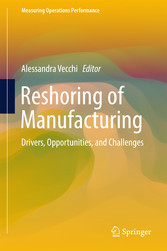Suchen und Finden
Contents
6
Defining the Field of Enquiry
8
1 Manufacturing Reshoring Explained: An Interpretative Framework of Ten Years of Research
9
Abstract
9
1 Introduction
10
2 Methodology
11
3 The Extant Literature
14
3.1 The “What” of Reshoring
14
3.2 The “Who” of Reshoring
17
3.3 The “Why” of Reshoring
18
3.4 The “How” of Reshoring
29
3.5 The “Where” of Reshoring
36
3.6 The “When” of Reshoring
37
4 Concluding Remarks: Where Reshoring Research Stands Now and Where It Might Go
37
References
40
2 Offshoring Versus Reshoring? Rather, Shouldn’t It Be Rightshoring?
44
Abstract
44
1 Introduction
45
2 Literature Background
45
2.1 Offshoring, Reshoring and Rightshoring: A Brief Description
45
2.2 Offshoring and Reshoring as a Location Decision
46
3 Methods
49
4 Empirical Findings
50
4.1 Company A
50
4.2 Company B
51
4.3 Company C
51
4.4 Company D
52
4.5 Company E
52
4.6 Company F
53
4.7 Company G
54
4.8 Company H
55
5 Cross-Case Analysis
55
6 Conclusions
57
References
59
3 Complementing the Reshoring of Manufacturing Activities: The Relocation of Business Functions
62
Abstract
62
1 Introduction
62
2 The Reshoring Drivers, Opportunities and Challenges
64
3 Methodology: Evidence from the ORN Survey
66
3.1 Descriptive Statistics
66
4 Concluding Remarks
77
References
79
Enablers and Drivers
81
4 Knowledge Transfer in Reshoring
82
Abstract
82
1 Introduction
82
2 Literature Review
83
2.1 Reshoring
83
2.2 Knowledge Transfer
84
2.3 Knowledge Transfer Factors
86
2.4 Organizational Factors
86
2.5 Interpersonal Factors
86
2.6 Knowledge Transfer in Reshoring
88
2.7 Challenges of Knowledge Transfer in Reshoring
89
3 Method
90
4 Empirical Data
91
4.1 Offshoring and Reshoring Background—Company A
91
4.2 Offshoring and Reshoring Background—Company B
93
4.3 Offshoring and Reshoring Background—Company C
95
5 Analysis
96
6 Study Contributions
98
References
99
5 Is 3D Printing an Enabling Technology for Manufacturing Reshoring?
102
Abstract
102
1 Introduction
102
2 Literature Review
104
2.1 Manufacturing Reshoring
104
2.2 Additive Manufacturing
105
2.3 Additive Manufacturing Technologies and the Supply Chain
109
3 Methodology
111
4 Results
115
5 Conclusion
123
References
124
6 Blockchain and Sensor-Based Reputation Enforcement for the Support of the Reshoring of Business Activities
128
Abstract
128
1 Introduction
129
2 Architecture
132
2.1 Real-Time Assessment
132
2.2 Accessibility to Reliable Information
133
2.3 Enforcing Participatory Trust and Reliability
134
3 Methods
136
4 Use Cases
137
4.1 Organic Farming
137
4.2 Made in Italy
138
4.3 A Practical Cheating Example
138
5 Conclusion
139
References
140
Emblematic Evidence
143
7 Reshoring Strategy: Case Illustrations of Japanese Manufacturing Firms
144
Abstract
144
1 Introduction
145
2 Literature Review
145
3 Case Selection Process
150
4 Finding of Case Studies
151
4.1 Case of Air Conditioner Firm
151
4.1.1 An Overview of Toyotomy Corporation
151
4.1.2 Air Conditioners for Global Market
152
4.1.3 Learning Outcomes Through Strategic Alliance with Konsaku Corporation
153
4.1.4 Reshoring Strategy
154
4.2 Health Care Firm Case
156
4.2.1 An Overview of Ohashi Corporation: A Healthcare Firm
156
4.2.2 Ohashi Corporation’s Production System Reform
157
4.2.3 Reshoring Strategy of Ohashi Corporation
158
5 Discussion
159
6 Conclusion
159
References
160
8 The Chinese Bittersweet Cake in Orbea’s Internationalization
163
Abstract
163
1 Introduction
164
2 Literature Review
164
2.1 Going International: Motivations, Location and Mode
164
2.2 Offshoring and Reshoring
166
3 The Bicycle Sector
168
3.1 Definition of the Sector
168
3.2 The Firm Orbea and Its Internationalization
170
4 Methodology and Data
171
5 Analysis and Discussion
171
5.1 Going to China
171
5.2 The Offshoring Strategy
173
5.3 The Bittersweet Experience
175
6 Conclusions
178
References
179
9 Country of Origin: Reshoring Implication in the Context of the UK Fashion Industry
182
Abstract
182
1 Introduction
183
2 Literature Review: Setting the Scene—The Changing Roles of Retail and Manufacturer Brands in the UK Fashion Industry
183
2.1 Country of Origin Historical Overview
185
2.2 Dimensions of Country of Origin
186
2.2.1 Country of Manufacture
187
2.2.2 Country of Design
188
2.2.3 Country of Parts
189
2.2.4 Country of Brand Origin
190
3 Methodology
191
4 Findings: Country of Origin Implications for Re-Shoring
192
4.1 Country of Manufacture: Implications for Re-Shoring
193
4.2 Country of Design: Implications on Re-Shoring
194
4.3 Country of Parts: Implications for Reshoring
194
4.4 Country of Brand Origin—Implications of Re-Shoring
195
5 Conclusion
195
5.1 Managerial Implications
197
5.2 Limitations
197
5.3 Future Research Direction
198
References
198
10 Reshoring: A Stage in Economic Development or a False Patriotic Tune? The Case of the Polish Apparel and Footwear Industry
201
Abstract
201
1 Introduction
201
2 Theoretical Background
203
2.1 Is Reshoring a Return to Home?
203
2.2 Drivers of Reshoring
204
2.3 Political Resonance of Reshoring
205
2.4 The Characteristics of the Global Apparel Industry
208
2.5 Customer Perception of the Value Chain and Its Impact on Reshoring Activities
211
3 Method
213
4 Findings, Discussion
214
4.1 The Evolution of the Polish Apparel Industry and the Emergence of Reshoring and Near-Reshoring—Statistical Analysis and Anecdotal Evidence from the News
214
4.2 E-Survey Results Amongst Companies in the Polish Apparel Industry
219
4.3 Questionnaire Amongst Consumers in Poland
223
5 Conclusions
227
5.1 Managerial Implications
228
5.2 Limitations and Further Research Ares
229
References
230
Alle Preise verstehen sich inklusive der gesetzlichen MwSt.













